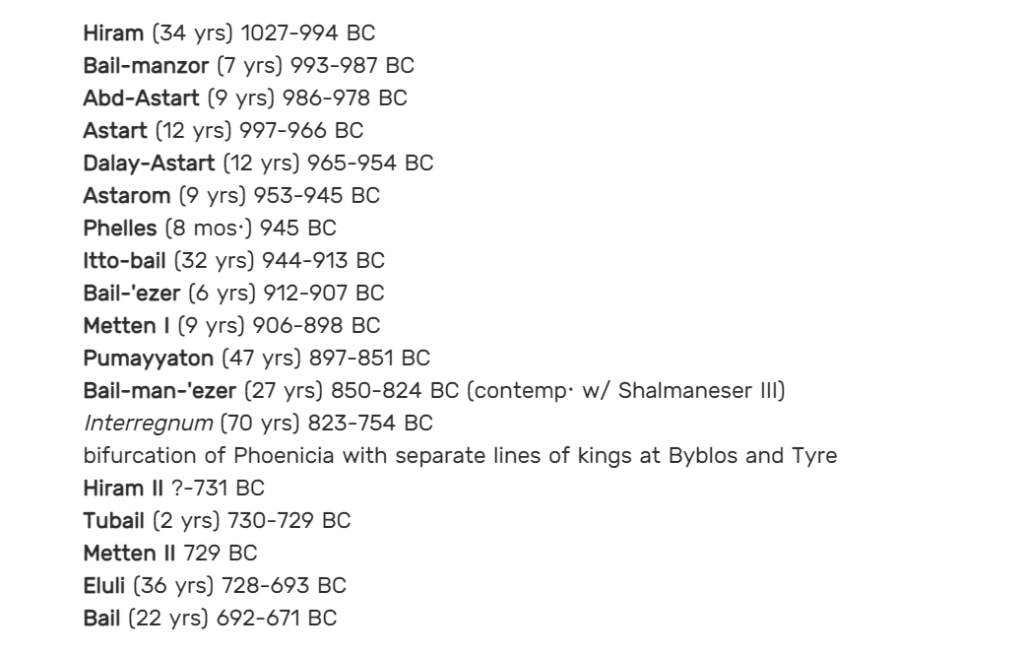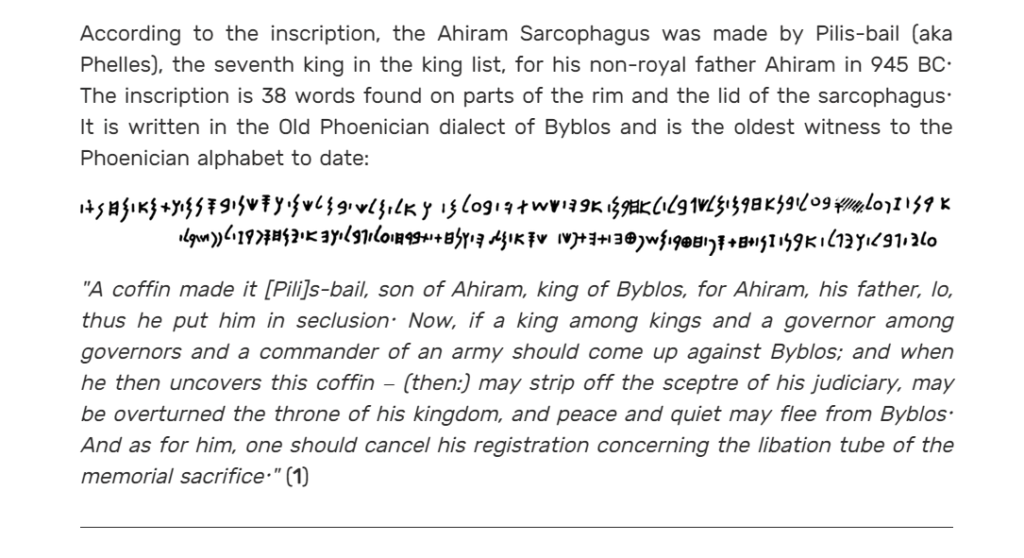The so-called Ahiram Sarcophagus discovered in 1923 by French archaeologist Pierre Montet in Jbeil, Lebanon (ancient Byblos of the Sidonians), is the oldest known Phoenician-Canaanite inscription. The sarcophagus is currently preserved in the National Museum of Beirut. The item and its inscription appears to date to the 10th century BC, and probably 945 BC to be exact.
Below is the list of the Phoenician-Canaanite kings of Tyre and Sidon (and Byblos) and the dates of their reigns according to the ancient sources which include the Bible, the royal inscriptions of the kings of Assyria, and excerpts of Menander of Ephesus in the writings of the first century historian Josephus:

The first king in the list, Hiram, was a contemporary of kings Doayd (David) and his son and successor Shalamah (Solomon). It was Hiram who supplied much of the material and the manpower in order to build the First Temple in Yaroshalam (Jerusalem).

Pilis-bail (Phelles) reigned for a brief 8 months and then he was murdered by his successor Itto-bail, the priest of Astarte,(2) who became king for 32 years (944-913 BC). This is the same king of Sidon mentioned in the Bible in 1 Kings 16:31. His infamous daughter Ayzabal (Jezebel) became the wife of king Akhab (Ahab) who reigned over Ya’ohsharal for 22 years (922-901 BC).
Thus, the oldest known “Canaanite” inscription is not older than the United Monarchy of Ya’ohsharal which commenced in the 11th century in the year 1059 BC with the accession of Sha’ol (Saul). Doayd established a new dynasty 2 years later in 1057 BC and his son Shalamah began his reign 40 years later in the year 1018 BC. To help put things into more perspective, the Ahiram Sarcophagus made by Pilis-bail in 945 BC was not made until 34 years after the death of Shalamah in 978 BC.
More crucially, the “Canaanite” inscription on the Ahiram Sarcophagus is also not older than the Megiddo Seal (shown above) discovered in 1904 by an archaeological team led by Gottlieb Schumacher. This oval-shaped, scaraboid jasper seal belonged to a prominent servant of king Yarab-gham I (Jeroboam I) who reigned over Ya’ohsharal for 22 years (978-958 BC). Earlier proposals to date the seal to Yarab-gham II (834-794 BC) are countered by David Ussishkin, a prominent Israeli archaeologist who argues persuasively that it must date to the earlier 10th century BC ruler of the same name. (3) In other words, the oldest known “Canaanite” inscription is not older than the oldest known inscription which is definitely of “Israelite” (and not Canaanite) manufacture.
The relative dating becomes important because of the scripts. A careful examination of the two script styles appearing on the Ahiram Sarcophagus and the Megiddo Seal will reveal how they are not identical. Similar but with enough differences between them to warrant classifying them as different styles. The Megiddo Seal is distinctively “Israelite” and utilizes the script style that remained fairly constant in Ya’ohsharal from the beginning to the end of the monarchy period and later. The script on the Ahiram Sarcophagus, on the other hand, is distinctively “Canaanite” and this script style was never utilized on any artifact of genuine ancient “Israelite” manufacture.
The analysis of Edward M. Cook’s and Benjamin Sass should also be mentioned here. Cook conclusively dismisses the proposed date in the 13th century BC for the oldest inscription in the great Phoenician Byblian corpus. (4) Benjamin Sass in turn argues for an even lower date for the entire corpus (i.e. the Ahiram Sarcophagus, the Yehimilk Inscription, the Abiba’al Inscription, the Eliba’al Inscription, and the Shipitba’al Inscription). According to Sass, these inscriptions all date to the period 850-750 BC time frame. Hence none of them are as old as our oldest attested “Israelite” inscription. (5)
What about Ugaritic?
Orthodox conventional scholarship assumes the Ugaritic alphabetic script for an extinct NW Semitic Amorite-Canaanite language existed in the 13th and 12th centuries BC. This dating would make Ugaritic with its so-called “long alphabet” of 30 letters the oldest example of the family of West Semitic scripts. However, this dating has been challenged by Egyptologist David Rohl who points out that a near-sunset solar eclipse observed from the city of Ugarit, and attested in the Ugaritic Tablet KTU 1.78, could only have occurred on the date of 9 May 1012 BC. It is in fact the only time during the whole second millennium BC when such an eclipse could have occurred according to the astronomical retrocalculations of astronomers Wayne A. Mitchell and David Lappin using computer astronomy programs.
This absolute date of 1012 BC derived by archaeoastronomy methods stands on its own and apart from David Rohl’s effort to utilize the datum in order to push the conventional dates for Akhenaten (1336-1320 BC) down by approximately 300 years, a chronological revision which is not plausible. (6)
In any case, we now know that the invention of the Ugaritic alphabetic script post-dates the reign of Nikmaddu II, the second ruler and king of Ugarit. The Akkadian language and script was being spoken and written at Ugarit during the reign of Nikmaddu II in the 14th century BC and he was contemporary with Akhenaten in Egypt.
The alphabetic cuneiform script peculiar to Ugarit was in use for no more than the last century of Ugarit’s existence, and most likely even less (ca. 50 years). (7) The evidence from archaeoastronomy and the flames that blackened Tablet KTU 1.78 show that the tablet was blackened by the flames of Ugarit’s final destruction sometime after 1012 BC. The speculative date for the end of Ugarit in 1190 BC (8) is simply too high. In other words, the invention of the Ugaritic alphabetic script dates to the middle of the 11th century BC, or more likely the beginning of the 10th century BC, not the 13th century BC.
Where does this leave us? Ugaritic cannot plausibly be considered to be the oldest of the family of West Semitic languages and scripts. The orthodox conventional assumption that the alphabetic script utilized by the ancient “Israelites” was obtained from the Canaanites is simply unfounded. The dates don’t add up. If anything, the opposite was the case and the Phoenician-Canaanites adopted and modified the “Israelite” script following the Conquest of the Levant by “Habiru” Ya’ohsharal in the 15th century BC. Eupolemus (second century BC) evidently had solid grounds for asserting that the Hebrew alphabet of the “Israelites” passed from them to the Canaanites and not the other way around. (9)
Notes:
1. Reinhard G. Lehmann, Die Inschrift(en) des Ahirom-Sarkophags und die Schachtinschrift des Grabes V in Jbeil (Byblos), (Mainz), 2005 (Forschungen zur phönizisch-punischen und zyprischen Plastik, hg. von Renate Bol, II.1. Dynastensarkophage mit szenischen Reliefs aus Byblos und Zypern Teil 1.2).
2. Josephus, Against Apion i.18.
3. Shanks, Hershel. “First Person: Have You Seen This Seal?” Biblical Archaeology Review 26, no. 1 (2000), p. 4.
4. Edward M. Cook, “On the Linguistic Dating of the Phoenician Ahiram Inscription (KAI 1)”, Journal of Near Eastern Studies 53.1 (January 1994), pp. 33-36.
5. Benjamin Sass, The Alphabet at the Turn of the Millenium: The West Semitic Alphabet ca. 1150-850 B.C.E. (Tel Aviv: Yass Publications in Archaeology, 2005), p. 49.
6. John J. Bimson, “Does Tablet KTU 1.78 provide ‘independent scientific confirmation of the New Chronology’?,” JACF 10 (2005), pp. 57-62.
7. P. Bordreuil & F. Malbran-Labat, ‘Les archives de la maison d’Ourtenu,’ Comptes Rendus de l’Academie des Inscriptions et Belles Lettres (1995), pp. 443-451; and La découverte épigraphique de 1994 à Ougarit, Studi micenei ed egeo-anatolici 36: 103–11; P. Bordreuil & D. Pardee, Manuel D’Ougaritique, Vo1. 1 (Paris, Geuthner, 2004).
8. John Huehnergard’s An Introduction to Ugaritic (Hendrickson Publishers, 2012), pp. 1-3.
9. Eusebius, Praep. 9.26.1.
